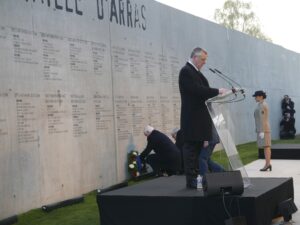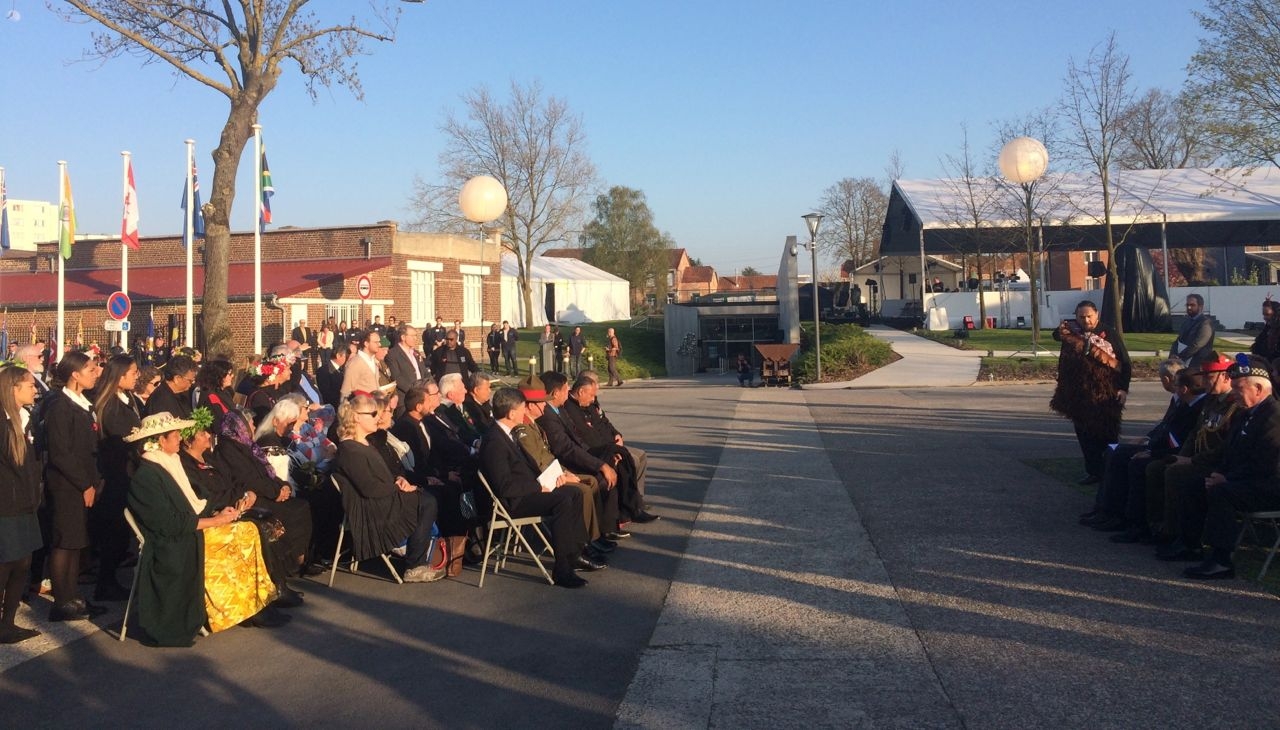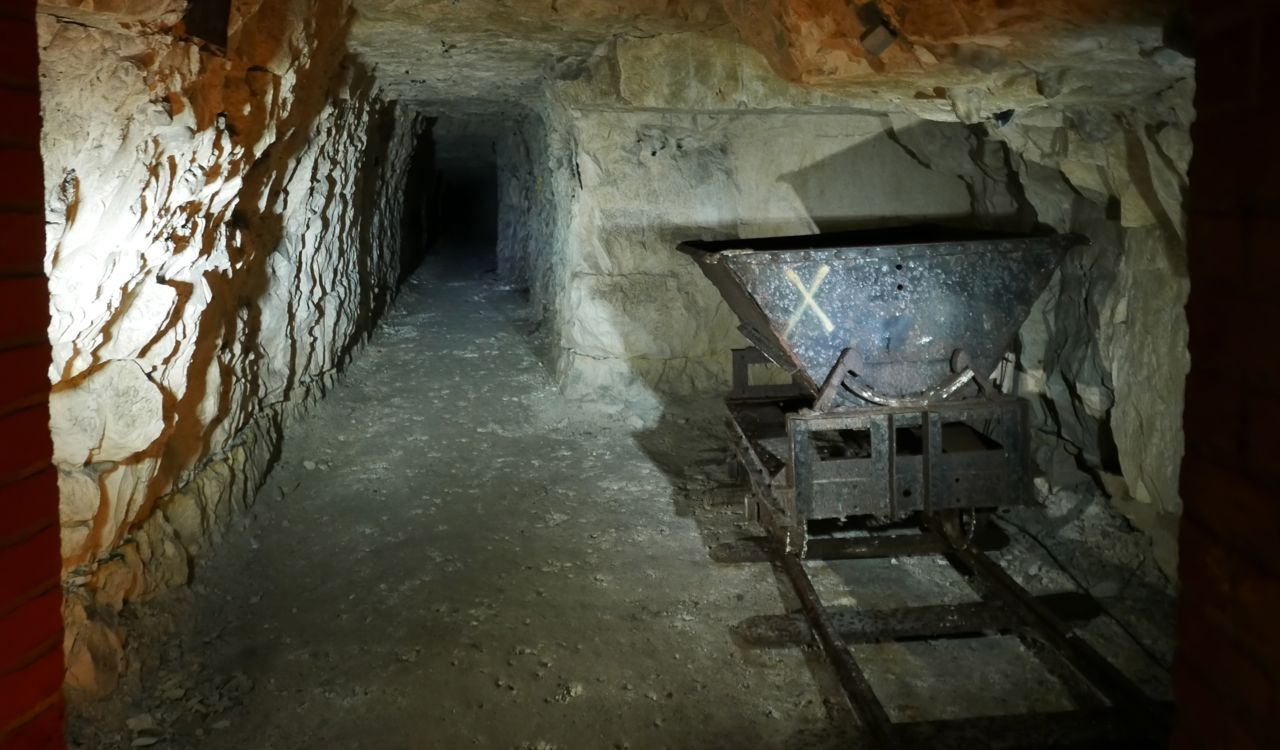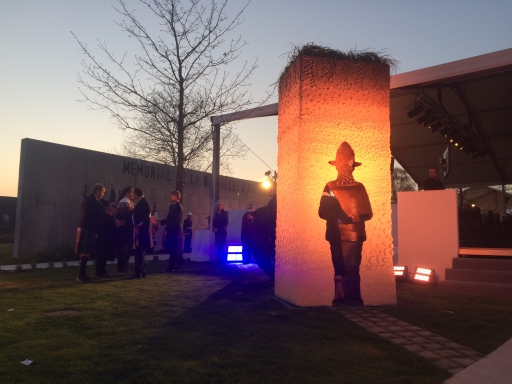Arras and Vimy Ridge hosted a day of commemorations on 9 April 2017 bringing together the nations who fought in the Allies’ first concerted Western Front offensive of 1917.
President François Hollande of France and the Canadian Prime Minister, Justin Trudeau, were joined at Vimy itself by Prince Charles, and his sons, Princes William and Harry. Events in and around the city of Arras paid tribute to the soldiers of all the countries involved, and in particular Canada, New Zealand and Scotland for whom the Battle of Arras has special resonance.
In the first of a series of articles, CN Editor Peter Alhadeff reports from the dawn opening ceremony, held at La Carrière Wellington.
The unveiling of The Earth Remembers, a strikingly novel monument to the men whose underground engineering feats enabled one of the greatest Allied surprises of the First World War, was the focus for a moving series of international tributes at daybreak.
On the morning of 9 April 1917, thousands of soldiers emerged from the network of shelters constructed by New Zealand and British tunnellers in cellars and disused quarries beneath Arras to attack the German lines.
100 years on, Mayor of Arras Frédéric Leturque and New Zealand’s Attorney General, Chris Finlayson, unveiled The Earth Remembers at La Carrière Wellington (Wellington Tunnels), the museum opened in 2008 as a memorial to those who fought at Arras.

Battle of Arras Memorial at La Carrière Wellington: Readings were introduced by Carl Liversage, Head of External Engagement for the Commonwealth War Graves Commission (Photo: Centenary News)
The ceremony, part of the international commemorations for the Battle of Arras, was attended by Canada’s Governor General, David Johnston, and the French Veterans Affairs Minister, Jean-Marc Todeschini, together with representatives from the UK, Australia, India, South Africa and Germany, and the people of Arras.
As the wreaths were laid, a day of brilliant sunshine dawned, so very different from the snow and ice that marked the opening of the battle on Easter Monday 1917.
Readings, many of them by local schoolchildren charted the story of Arras in the Great War, from the destruction wrought by the first German bombardments in 1914, to the arrival of British troops in 1916 as the French Army pulled out to reinforce Verdun, and the opening of the 1917 offensive.
Arras joined the ranks of Verdun, Reims and Soissons as ‘one of the martyred towns of that war’, Mayor Frédéric Leturque noted in his introduction to the Centenary programme.
Today’s commemorations, he said, would be ‘an opportunity for us to pay to pay tribute to the men and women from all walks of life, heroes of the 14-18 war, who came to fight not only in Arras but also the entire length of a front stretching from Vimy in the north to Bullecourt in the south – British, Canadians, New Zealanders, Australians, Indians, South Africans.’
Gratitude
It was a message of gratitude underlined on banners bearing the flags of the Allied nations, displayed on streets in city centre streets.
The soldiers of the New Zealand Tunnelling Company, drawn from mainly from the ranks of enlisted miners, played a crucial role in digging the tunnel network 20 metres below ground to hide Allied troops from German view in the run-up to the offensive.
Designed and made by Marian Fountain, a New Zealand artist based in Paris, The Earth Remembers is a centenary tribute to their endeavours.
The bronze memorial features the immediately recognisable silhouette of a New Zealand soldier wearing a characteristic ‘lemon squeezer’ hat.
Visitors are invited to pass through the ‘dug out’ shape, glimpsing an army of sculpted figures, as well as poignant extracts from soldiers’ letters to their families.
 Descendants of the tunnellers gathered for a traditional Mori ceremony at Carrière Wellington (Photo: Centenary News)
Descendants of the tunnellers gathered for a traditional Mori ceremony at Carrière Wellington (Photo: Centenary News)
A new gallery of portraits of the tunnellers, lining the approach to the museum, was unveiled on the eve of the Centenary commemorations at an event attended by relatives.
“These brave men strove to protect the town (of Arras) and they did so with tenacity, skill and more than a dash of Kiwi ingenuity,” said Chris Finlayson, who launched New Zealand’s First World War Centenary programme as Arts, Culture and Heritage Minister in 2014.
“The New Zealand Tunnelling Company and the Mori Pioneer Battalion had to carry out work not only at breakneck pace but with as much stealth as possible.
“They were regarded by other troops as hardworking and industrious. In four and a half months they helped to create nearly ten kilometres of tunnels.
“They were practical and innovative, making small but effective changes to the ways things were normally done.”
 One of the Wellington tunnels dug during the First World War (Photo: Centenary News)
One of the Wellington tunnels dug during the First World War (Photo: Centenary News)
In another Arras Centenary tribute, The Poppy of Peace – Victory Medal, the work of Helen Pollock, also a New Zealand sculptor, was displayed in the Place des Héros, the elegant square in front of the Hôtel de Ville (town hall).
Visitors were invited to leave individual messages of remembrance on red discs forming the shape of a giant poppy, with rows of feet at the centre, symbolising New Zealand soldiers.
President Hollande and Canadian Prime Minister Justin Trudeau joined in adding their tributes before taking part in the Battle of Vimy Ridge Centenary commemorations at the Canadian National Vimy Memorial.
Also in Centenary News:
Read a Summary of the Battle of Arras here.
Canada marks pivotal battle of Vimy Ridge
Scotland remembers its Battle of Arras soldiers at Faubourg d’Amiens Cemetery.
Fields of Battle Through Canadian Eyes – Canadian First World War touring art exhibition in Arras.
Canadians in the Great War – exhibitions in the Béthune-Bruay region, Artois.
Eyes of the Battle of Arras – photo displays line Arras city centre streets
—————————————-
Visit the official Arras 14-18 website for information about the Centenary programme
Posted by CN Editor Peter Alhadeff, reporting from Arras
All images: Centenary News
